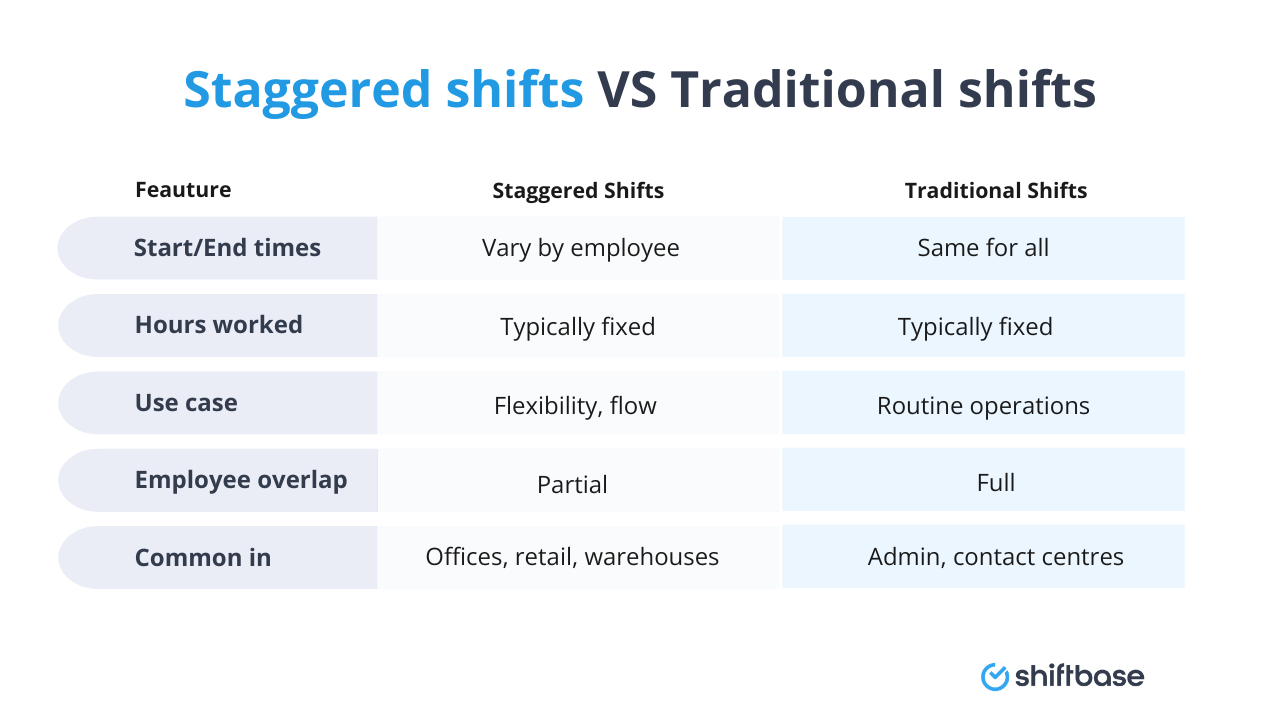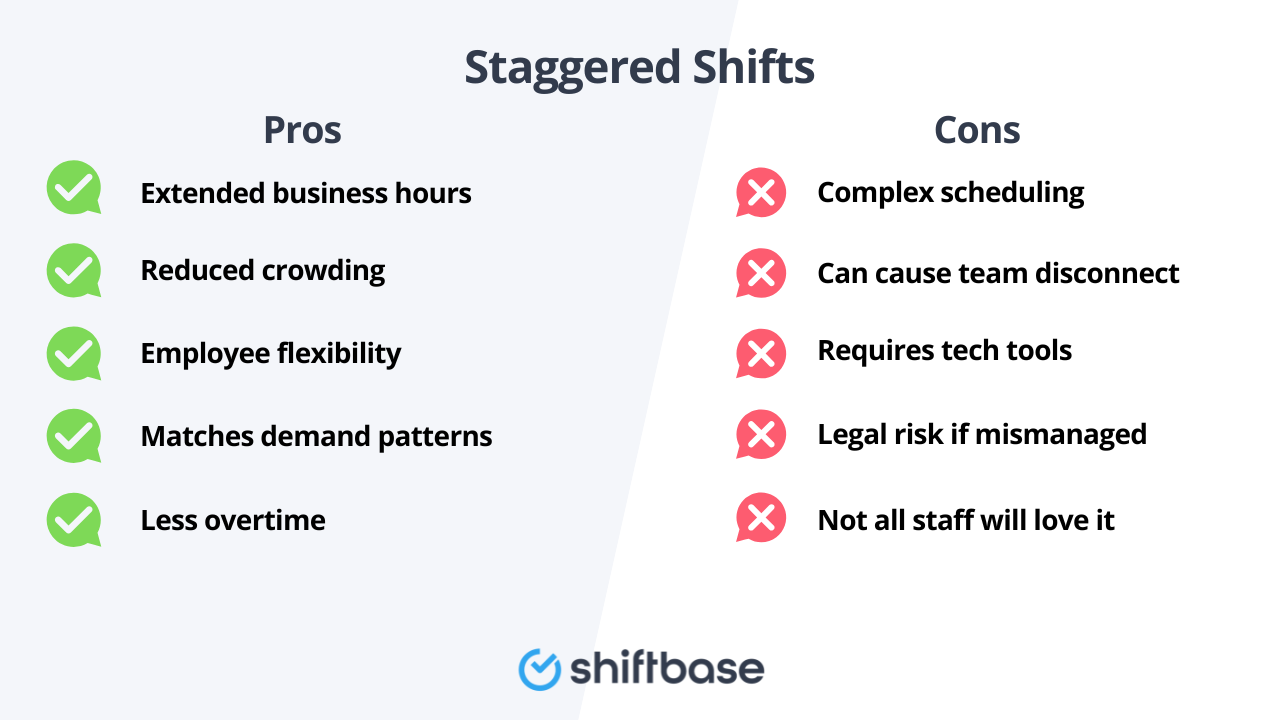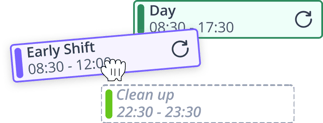In this guide we delve deeper into understanding the staggered shift approach, its implications, and how it's managed.
What are staggered shifts?
Staggered shifts (also known as staggered hours) are work schedules where employees start and finish at different times, rather than everyone clocking in and out together. It’s not about reducing total hours, just spreading them out.
Let’s say your usual business hours are 9 to 5. Instead of having all your staff show up at 9am, you might have:
-
Alice work 7am–3pm
-
Ravi work 9am–5pm
-
Zara work 11am–7pm
Same number of hours, different start and finish times.
This approach is often used in:
-
Retail and hospitality, to match peak footfall
-
Offices, to reduce traffic or overcrowding (especially since COVID-19)
-
Factories and warehouses, to maximise output over longer periods
-
Healthcare or security, where 24/7 cover is needed
Key features of staggered shifts:
-
Not the same as shift work, which often rotates (e.g. night shift → day shift)
-
Hours are fixed, just offset
-
Can be temporary (e.g. during busy season) or permanent
-
Still need to follow working time rules—more on that below
Why do employers use staggered hours?
Because having everyone start at 9am isn't always the smartest move. Here’s what staggered shifts help solve:
-
Overcrowding – Avoids a bottleneck at entrances, break rooms, or changing areas
-
Customer coverage – Matches staffing levels to high-traffic periods
-
Staff flexibility – Gives employees more say in when they work (which can boost morale)
-
Operational efficiency – Extends daily coverage without adding overtime
-
Emergency planning – Useful during pandemics, strikes, or severe weather events

Who sets staggered hours?
Usually, it’s the employer’s decision, but you’ve got to follow some ground rules. For example:
-
You may need employee agreement if it changes their contract
-
In the UK, employees can now request flexible hours (including staggered ones) from day one
-
In unionised workplaces, staggered shifts might need collective bargaining or consultation
Legal considerations for staggered shifts
If you’re planning to introduce staggered hours, you’ll need to stay on the right side of the law. Let’s walk through the key things to consider:
🇬🇧 In the United Kingdom
Flexible working requests
As of April 2024, under the Employment Relations (Flexible Working) Act 2023, employees can now:
-
Request flexible working—including staggered hours—from their first day of employment
-
Make two formal requests per year
-
Receive a decision within two months
⚠️ Tip: You must consult with the employee before refusing a request, and you need a valid business reason to say no.
Contractual changes
If you want to introduce staggered shifts across your team, check:
-
Do current contracts specify set hours?
-
Do you have a variation clause?
You may need written consent if you're changing someone’s hours or start/end times. It’s always safer to consult and document.
Working Time Regulations 1998
You still have to comply with the usual rules:
-
Max 48 hours per week (unless opted out)
-
At least 11 hours of rest between shifts
-
20-minute break if working over 6 hours
-
One day off every 7 days (or two days in 14)
Even with staggered shifts, employees must not be overworked or denied rest breaks.
New rights coming soon (Employment Rights Bill, expected 2025–2026)
| What’s changing | What it means for staggered shifts |
|---|---|
| Right to request a contract reflecting actual hours (after 12 weeks on the job) | If someone works the same staggered hours regularly, they can ask for it in writing |
| Reasonable notice for shift changes | You'll need to give fair warning before adjusting someone’s staggered shift last minute |
| Compensation for late cancellations | Short-notice shift cancellations may require financial compensation |
| Exemption for unionised workplaces | If covered by a collective agreement, some obligations may not apply |
Useful Read: What Actually Counts as ‘Working Time’ For Paid Breaks and Split Shifts?
🇺🇸 In the United States
Staggered shifts aren’t directly regulated, but here’s what you need to keep in mind:
Federal labour laws (FLSA)
-
Employees must be paid for all hours worked
-
Time between shifts may trigger overtime if it exceeds 40 hours/week
-
Split shifts (common in staggered systems) may lead to extra pay in California and New York
State and city-level rules
Some states and cities have their own requirements:
-
Predictive scheduling laws (e.g., in Oregon, NYC, San Francisco): require advance notice of schedules
-
Split shift premiums in certain sectors
-
Paid sick leave and family leave laws can impact how staggered hours are managed
✅ Best practice: Use scheduling software that’s compliant with local rules and can track shift changes or cancellations.
Pros and cons of staggered shifts
Like any scheduling system, staggered shifts have their ups and downs. Let’s take a look at both sides so you can decide if it’s worth implementing in your workplace.
👍 The benefits (why employers love them)
- Better coverage throughout the day: You can stretch your business hours without burning through overtime. Great for places that get busy early or late—like bakeries, call centres, and gyms.
- Less crowding = smoother operations: No more 9am stampede at the clock-in machine or coffee queue. Spacing out shifts keeps common areas calmer and more hygienic (COVID-19 taught us well).
- Boosts employee satisfaction: Many staff prefer starting earlier or later depending on childcare, commuting, or personal preference. Offering options makes your company more attractive.
- Matches staffing to real demand: You can plan shift patterns based on footfall, deliveries, or workload—no need to overstaff during slow periods or panic during peak times.
- More business flexibility: Need to cover longer hours without hiring more people? Staggered shifts let you do that with your existing team.
👎 The downsides (and how to handle them)
- More admin work: Different start/end times mean you’ll need a proper rota system—Excel won’t cut it for long. 👉 Try a workforce management tool like Shiftbase (yep, a shameless plug, but it works).
- Communication can slip: If everyone’s on different schedules, updates and team meetings become tricky. 👉 Use shared calendars and communication tools like Slack or MS Teams.
- Not everyone likes late shifts: Especially if public transport is limited or they have evening commitments. 👉 Ask for shift preferences where possible—don’t assume.
- Legal risk if poorly handled: Last-minute changes or unclear contracts can lead to grievances or even legal claims. 👉 Put it in writing, follow the Working Time Regulations, and give enough notice.
- Harder to track breaks and overtime: You’ll need to keep an eye on who’s taking breaks and when someone crosses into overtime territory. 👉 Use digital time tracking to stay on top of it (manual logs = mistakes).

How to implement staggered shifts
Introducing staggered shifts doesn't have to be a logistical nightmare. Follow these simple steps to roll them out in a way that's fair, legal, and actually works for your team.
Know your “why”
Before you start messing with schedules, be clear on the reason:
-
Are you trying to extend business hours?
-
Solve overcrowding in the break room?
-
Give staff more work-life flexibility?
-
Match staffing with customer demand?
💡Having a clear goal makes it easier to explain the change and get buy-in.
Audit current contracts and policies
-
Do employee contracts say fixed hours?
-
Do you have a flexibility clause?
-
Are your policies up to date with UK or US law?
If you're changing working hours, you may need to:
-
Consult staff
-
Get written agreement
-
Update contracts
Ask for staff input (and actually listen)
-
Some staff prefer early shifts
-
Others rely on school drop-offs or late trains
-
Someone’s quietly dreading change but won’t say unless asked
💡Tip: Do a quick survey or informal chats before finalising anything.
4. Design your new rota
Use a rota builder or workforce management tool to test different schedules. You want to:
-
Avoid overlap overload
-
Make sure everyone gets their contracted hours
-
Spread shifts fairly
Sample staggered shift schedule table for a retail shop:
| Name | Mon | Tue | Wed | Thu | Fri |
|---|---|---|---|---|---|
| Jade | 7–3 | 7–3 | OFF | 7–3 | 7–3 |
| Omar | 9–5 | 9–5 | 9–5 | OFF | 9–5 |
| Ellie | 11–7 | OFF | 11–7 | 11–7 | 11–7 |
Communicate the change clearly
Don’t just post a new rota and hope for the best. Let people know:
-
What’s changing
-
Why you’re doing it
-
How it affects them
-
What to do if they have concerns
💡Use multiple channels: in person, email, noticeboards, chat apps. Repeat often.
6. Trial it before going all-in
Try the new schedule for 2–4 weeks and then get feedback. Ask:
-
Did it help operations?
-
Any gaps in coverage?
-
Are employees coping okay?
💡If it’s working, make it official. If not, tweak and retry.
Document everything
-
Update contracts or addendums
-
Refresh your rota policy
-
Train managers on how to handle flex requests and last-minute changes
🗂️ Keep records of:
-
Who agreed to what
-
When changes were made
-
How you consulted people
Bonus: Top tools that make this easier
-
✅ Shiftbase – scheduling, time tracking, contract management
-
🗓 Google Calendar – for team visibility
-
🧾 Slack / Teams – for shift comms
-
📊 Excel (with caution) – OK for small teams, risky at scale
Useful Read: Excel + WhatsApp vs Shiftbase: The True Cost of Rotas, Time Edits and Payroll Errors


How Shiftbase makes staggered shifts easy to manage
Managing staggered shifts manually can be a nightmare. Between juggling employee preferences, legal rules, and last-minute changes, it’s way too easy to lose track.
That’s where Shiftbase comes in. Our workforce management software takes the stress out of scheduling by giving you the tools to plan, adjust, and track staggered hours in just a few clicks.
With employee scheduling, you can build smart rotas that balance staff coverage and flexibility. Need to schedule Jade for an early shift and Omar for a late one? Easy. Want to copy that pattern across multiple weeks? Done.
The time tracking feature makes sure you’re not guessing who worked when—it records start and end times automatically, and flags any missed breaks or potential overtime. Plus, absence management ensures you always know who’s off, so you’re never caught short-handed.
No more paper rotas, no more Excel chaos, no more complaints about missed shifts. Just better visibility, happier staff, and smoother operations.
👉 Ready to take the headache out of staggered shifts? Try Shiftbase free for 14 days
Start your free trial here—no credit card needed!
